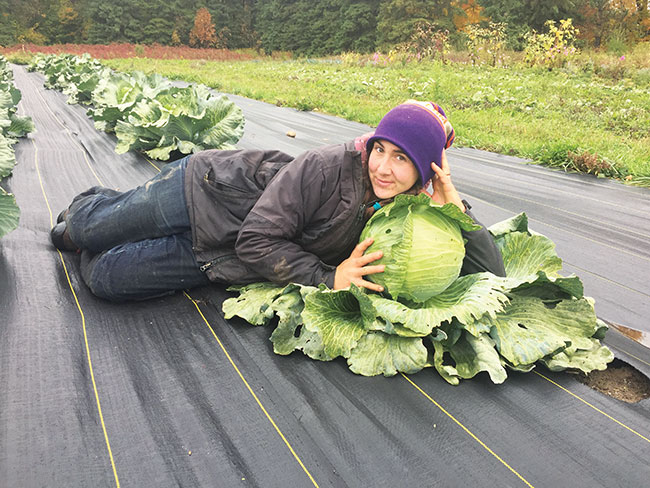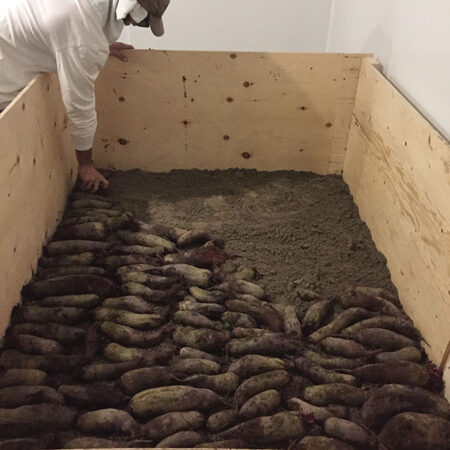
Features
Local Spotlight
Storage
Keeping it cool
Pick your storage veggies, know your variables, start small and, above all, stay cool.
February 14, 2023 By J.P. Antonacci
 Sarah Dolamore, farm manager at Mount Wolfe Farm, shows off the cabbage crop.
All photos courtesy of Sarah Dolamore.
Sarah Dolamore, farm manager at Mount Wolfe Farm, shows off the cabbage crop.
All photos courtesy of Sarah Dolamore. Most community-supported agriculture (CSA) programs close up shop in the fall when the weather cools. But farms that store winter vegetables can provide local produce to their customers all year long.
“There’s so many ways to go about it,” said Sarah Dolamore, farm manager at Mount Wolfe Farm in Caledon, Ont., whose CSA runs from May to March and offers members a selection of roughly 30 different summer and winter vegetable crops.
Mount Wolfe Farm stores four main types of winter vegetables – brassicas, squashes, alliums and root vegetables – in a cold room that keeps produce at just above the freezing mark.
The structure is foam-insulated and has plastic cladding on the inside. Summer cooling is provided by a CoolBot, an electronic device commonly used by small-scale farmers that overrides a household air conditioner to work below factory settings.
The insulation and a concrete slab under the structure provide enough warmth that a heater is not needed until temperatures drop to around -20 C.
Different areas of the storage room have different temperature settings, allowing for vegetables with different optimal storage temperatures and humidity requirements to be kept in the same space.
“This is relatively low-tech storage stuff, as we move toward a potentially low-energy economy,” Dolamore says. “It’s great that people are coming up with programmable apple bins, but I don’t think everybody who wants to grow their own food has access to that technology or is producing at a scale that makes the investment economically viable.”
The key to storing winter vegetables is controlling light, temperature and humidity. Storage environments should be kept dark – as exposure to light will reduce storage life by signalling to the vegetables that it’s time to grow – aerated and free of standing water.
For specifics on optimal storage temperature, relative humidity and length of storage, Dolamore consults a reference guide available online from Cornell Co-operative Extension that classifies vegetables based on what storage conditions they prefer.
The farm’s cold room does the trick, but nothing beats an actual subterranean root cellar, she adds. “I wish we had one. Trying to build something to emulate what the earth does naturally feels a bit futile,” Dolamore says. “In the long run, I would say, build a root cellar. Because it’s the thermal mass of the soil that’s going to regulate the temperature and the humidity, instead of having to do it yourself by design or electronically.”
Waste not, feed lots
Mount Wolfe Farm began as a 70-acre, ecological family farm enterprise and CSA in 2016. Members pay at the beginning of the growing season and share in the harvest throughout the year.
Interest in the CSA spiked during the pandemic as residents went in search of safe, fresh food grown close to home. Enrolment has since levelled off at around 80 members, with those in smaller households opting for half-shares.
In the summer and fall, around 50 full-share equivalents are picked up every Friday by CSA members who choose their own produce in a market-style setting.
In the winter and spring, Dolamore and her colleagues pack and deliver customized veggie boxes every other week to about 30 members in the greater Caledon area, augmenting their stored crops with locally sourced apples and microgreens.
As winter begins, the veggie boxes are filled with leeks, radicchio, Napa cabbage and other late-season vegetables harvested to avoid frost damage and placed into short-term storage. “It’s stuff that can hold, but it’s not going to hold for very long,” Dolamore says. “We definitely have to send it out before Christmas.”
Root vegetables
Root vegetables like carrots, beets, turnips and radishes need cold and moist storage conditions to trap the crop’s sugars inside during hibernation. These vegetables should be harvested as near to peak maturity as possible and must not be allowed to freeze in the field.
After the harvest, trim the foliage to about a half-centimetre of stem. “Don’t wash them,” Dolamore says. “In fact, you want to agitate the skin as little as possible, because any kind of nick or trauma to the root will be a place where it will rot.”
Small-scale or homestead farmers may cover their root vegetables in sawdust or chopped leaves for storage, but at Mount Wolfe Farm, Dolamore layers them in lightly moistened sand “like lasagne” to keep them from drying out in long-term storage. “If something goes wrong with the temperature regulation at any point during the season, (the vegetables) are insulated against big fluctuations,” she says.
An alternative is storing the produce in plastic bags or stackable crates, with the entire room humidified to a moist level.
Dolamore recommends sowing root vegetables in mid- to late June “to not only get them established, but get them to size up to a point where it’s worth storing a really nice thick carrot, as opposed to a spindly one.”
Growers should choose varieties that are best suited for cold storage, which are often heirlooms.
“You have to do some trial and error to find your preferred varieties,” Dolamore says. As an example, certain summer carrot varieties “taste like sawdust after two months in storage,” but varieties bred to be stored over winter come out sweet and crunchy in May.
“Read the seed catalogue carefully, and talk to other growers in your community about their experiences,” Dolamore says.
Brassicas
Like root vegetables, brassicas do well in cool and humid storage conditions.
Mount Wolfe Farm grows two varieties of cabbage – one green and one red, with the red variety having a much shorter storage life. That is typical of purple vegetable varieties in general, which are eye-catching but don’t store as well or grow as robustly as green varieties.
Heads of cabbage destined for veggie boxes in November or December can survive in storage until delivery day. To make cabbages last into the new year, 80 per cent of the leaves are removed before the entire plant is harvested – stem, roots and all – and put into storage.
“That really keeps the plant from decaying and dormant – it thinks it’s still alive, because it’s still attached to its stem and it still has roots,” she says.
When the cabbage is needed in a veggie box, the few remaining buffer leaves are removed.

Dolamore recommends layering harvested root vegetables in lightly moistened sand “like lasagne” to store them.
Alliums
Storing garlic, onions and other cured alliums over the winter involves keeping humidity down, as these crops prefer cool and dry conditions.
At Mount Wolfe Farm, garlic and onions are kept inside what Dolamore calls an “allium closet:” a plastic-covered corner within the main storage room with shelving and a dehumidifier.
“That closet lives within our cooler, and it’s the heat generated by the dehumidifier that keeps it warmer than the surrounding area,” she says. “That’s a fast way to create that microclimate for allium storage without building a completely separate storage facility for them.”
The allium closet is worth the investment so garlic won’t go mouldy and waste a year’s work, Dolamore adds.
“I have lived the woes of trying to store garlic and it’s too moist,” she says. “With garlic especially, there’s so much labour tied up in that crop.”
She harvests onions and garlic in July and cures them in the barn, while squashes cure in the greenhouse.
“It just has to be dry and warm-ish for alliums to cure properly,” Dolamore says.
Sufficiently cured onions will have a fully sealed stem, with the greens having died back. “If you cut the stem and there’s still juiciness coming out of the onion side of it, it’s not dry yet,” Dolamore says.
For garlic, curing, processing and putting the plant into cold storage before the weather cools in the fall is of utmost importance.“You don’t want your garlic to get too cold for weeks and then put it in this warm storage; it’s all going to sprout,” Dolamore says.
Winter Squash
Some squash varieties, like acorn and delicata, do not need to be cured and can be included in veggie boxes in the fall or early winter. But proper curing is necessary to ensure longer-keeping winter squashes, like butternuts and hubbards, survive until their delivery day.
The goal with curing is to form a hard rind as a barrier to keep moisture in and mould-causing pathogens out. The Mount Wolfe team checks the squashes for blemishes or mould every few weeks. She is careful not to let the stems scratch the flesh during transport, since any cut can cause the vegetable to spoil.
Whether dealing with garlic, onions, or squash, “You really want to know what you’re doing before you store stuff,” Dolamore says. “Because at any point along the line, from variety selection, to harvesting, curing, and storage conditions, you could be unknowingly stacking the deck against the success of your crops.”
Challenges and rewards
Running a year-round CSA means farmers like Dolamore don’t get much of a break.
“Just as you’re finished the summer CSA, now we’ve got to harvest, process and pack away all the storage veggies,” she says. “It definitely adds complexity to the crop plan and the work plan.”
But she appreciates the “peace of mind” of being able to provide her family and CSA members with nutritious, locally grown food throughout the year.
“The way it knits together the year, to be able to do storage crops. I’m sowing this year’s seeds while still reaping the benefits of last year’s sowing,” she says.
“There’s also the feeling of resiliency from knowing we can last through the winter by the sweat of our brows. That kind of gratification that it’s not just a summer fling of having your own cherry tomatoes for a few weeks. I’m feeding myself and I’m feeding other people.”
Her advice to farmers considering winter storage is to pick a favourite vegetable and start small.
“Instead of storing 200 cabbages, do 10,” she says. “A full year of figuring it out on a low-stakes scale is a really good idea. But always have a mind to, ‘what would this look like to scale up?’”
Dolamore and her team have worked out how to successfully store winter vegetables at Mount Wolfe Farm, but she says there’s no one way to do it. Her advice to farmers is to read up on the general principles of cold storage and apply them to their specific operation.
“Like so many things about farming, it’s really about finding what fits best for your infrastructure and business model.”
Print this page